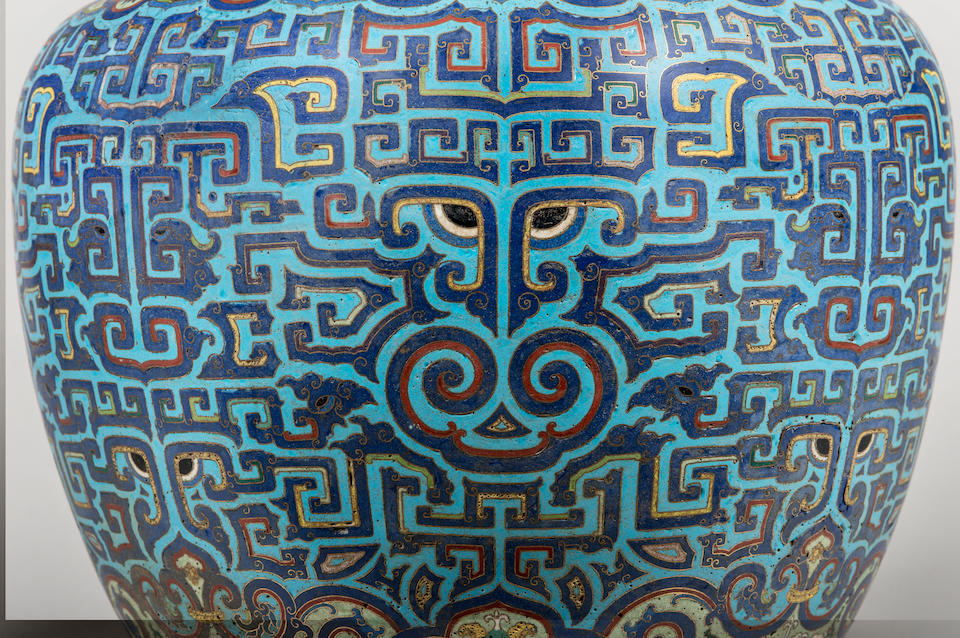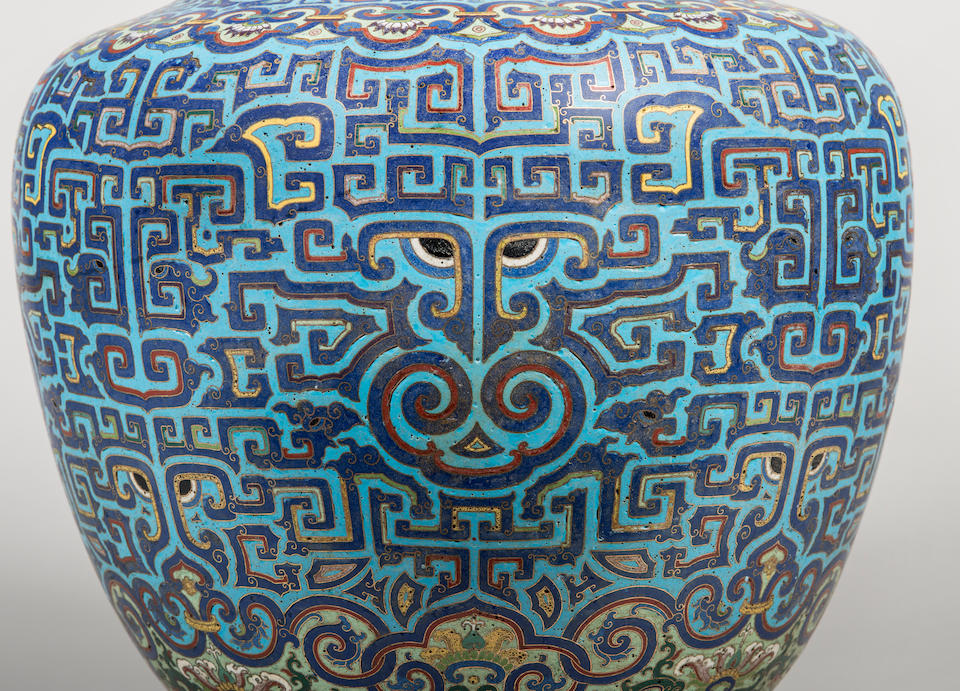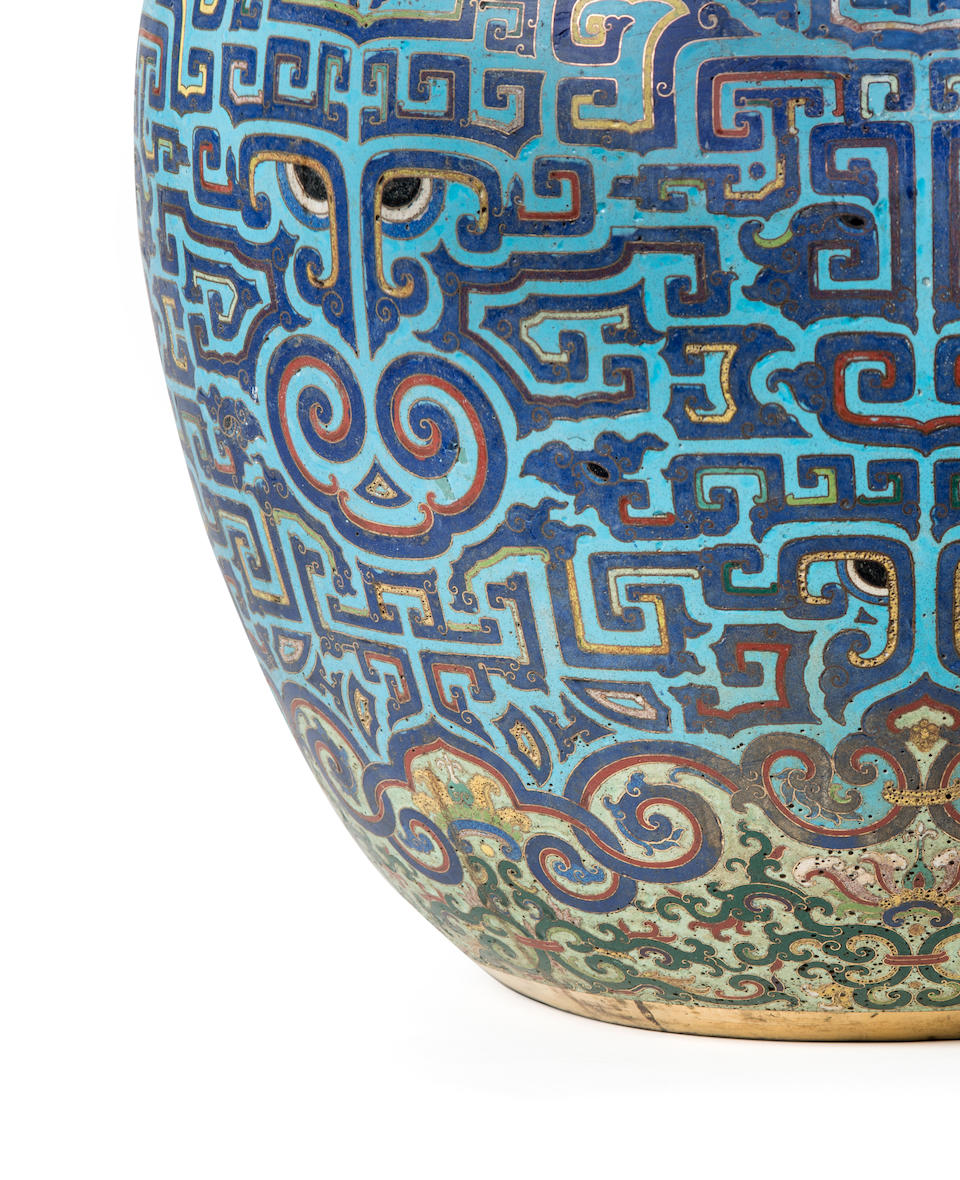A rare and large Imperial archaistic gilt-bronze and cloisonné enamel vase, zun, Qianlong period



Lot 58. A rare and large Imperial archaistic gilt-bronze and cloisonné enamel vase, zun, Qianlong period (1736-1795); 54cm (21 1/4in) high. Estimate: 900,000-1,200,000 HKD. Sold for HK$ 1,600,000 (€193,468). Sold for HK$ 1,600,000 (€ 190,505). Photo Bonhams.
Of globular form with high shoulders rising to a flaring neck and lipped rim, the body decorated with alternating large taotie masks above ruyi-heads amidst dense dark blue geometric and archaistic kui dragon scrolls, repeated in smaller size at the neck, with bands of linkedruyi-heads at the shoulder and below the mouth rim, the lower body above the base with a band of larger ruyi-heads enclosing alternating yellow and red lotus blooms borne on leafy tendrils, all on a rich turquoise ground.
Note: The present vase is very rare for its unusually large proportions, which allowed the master craftsman to demonstrate his skills on a significant scale. It is therefore likely that this vase was a special commission for the imperial court.
The decoration incorporating superbly rendered taotie masks and kui dragon archaistic scrolls, is inspired by archaic bronzes of the Shang dynasty. This is consistent with the Qianlong emperor's fascination and admiration for archaic and ancient objects. The emperor proposed to 'restore ancient ways', referring to the view of ancient culture as having intrinsic qualities of sincerity, simplicity and happy exuberance. For this purpose he instructed the court to collect drawings of antiquities, such as the Xiqing Gujian ('Catalogue of Xiqing Antiquities'), which were in turn provided to the craftsmen for inspiration; see Chang Li-tuan, The Refined Taste of the Emperor: Special Exhibition of Archaic and Pictorial Jades of the Ch'ing Court, Taipei, 1997, pp.49-50.
The advocated archaism was adapted to Qing dynasty aesthetic sensibilities, in form and design, to suit the more opulent aesthetic favoured by the Qianlong emperor. The present lot is a remarkable example of how archaic designs were creatively rendered in different ways yet still reflects echoes of 'ancient' style. This is demonstrated in the reinterpretation of the taotie masks with pronounced eyes set at right angled corners, situated above ruyi-head motifs. The incorporation of non-archaic motifs on the same object, such as the lotus flowers within ruyi-head borders and meanders of leafy stems, also brought a more lavish visual appeal, which combined with the considerable proportions of the present vase, resulted in an outstanding accomplishment.
Compare a cloisonné enamel zun with very similar alternating taotie masks, mid-Qing dynasty, illustrated in Compendium of Collections in the Palace Museum: Enamels 3, Beijing, 2011, pl.81. See also another example with comparable interlinked ruyi-head decoration illustrated by H.Brinker and A.Lutz, Chinese Cloisonné: The Pierre Uldry Collection, New York, 1989, no.228. See also a related archaistic cloisonné enamel vase, Qianlong, from the Brooklyn Museum, New York, illustrated in B.Quette, ed., Cloisonné: Chinese Enamels from the Yuan, Ming, and Qing Dynasties, New York, 2011, p.92, fig.5.20.
Cloisonné enamel zun, mid-Qing dynasty, 45 x 29 x 31 cm, illustrated in Compendium of Collections in the Palace Museum: Enamels 3, Beijing, 2011, pl.81. Image courtesy of the Palace Museum, Beijing.
For other cloisonné enamel zun vases of very similar shape, compare a slightly larger vase decorated with bats and peaches, and another smaller zun with leafy lotus sprays, mid-Qing dynasty, illustrated in Compendium of Collections in the Palace Museum: Enamels 3, Beijing, 2011, pls.79 and 80.
Bonhams. IMPERIAL SPLENDOUR, 3 Dec 2015 12:00 HKT - HONG KONG, ADMIRALTY

/https%3A%2F%2Fprofilepics.canalblog.com%2Fprofilepics%2F1%2F0%2F100183.jpg)
/https%3A%2F%2Fstorage.canalblog.com%2F03%2F02%2F119589%2F96711876_o.jpg)
/https%3A%2F%2Fstorage.canalblog.com%2F11%2F31%2F119589%2F94773502_o.jpg)
/https%3A%2F%2Fstorage.canalblog.com%2F20%2F83%2F119589%2F94772815_o.jpg)
/https%3A%2F%2Fstorage.canalblog.com%2F26%2F72%2F119589%2F75604929_o.jpg)
/https%3A%2F%2Fstorage.canalblog.com%2F59%2F60%2F119589%2F26458628_o.jpg)




/http%3A%2F%2Fstorage.canalblog.com%2F04%2F42%2F119589%2F129831017_o.jpg)
/http%3A%2F%2Fstorage.canalblog.com%2F53%2F21%2F119589%2F129409104_o.jpg)
/http%3A%2F%2Fstorage.canalblog.com%2F79%2F64%2F119589%2F129153779_o.jpg)
/http%3A%2F%2Fstorage.canalblog.com%2F97%2F23%2F119589%2F128165935_o.jpg)